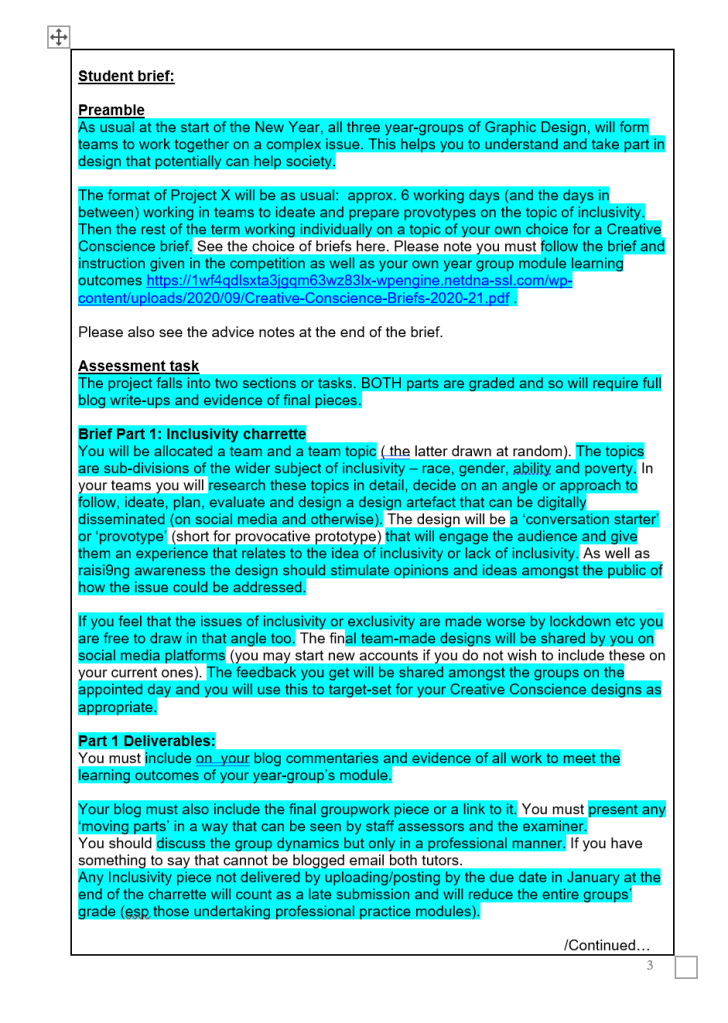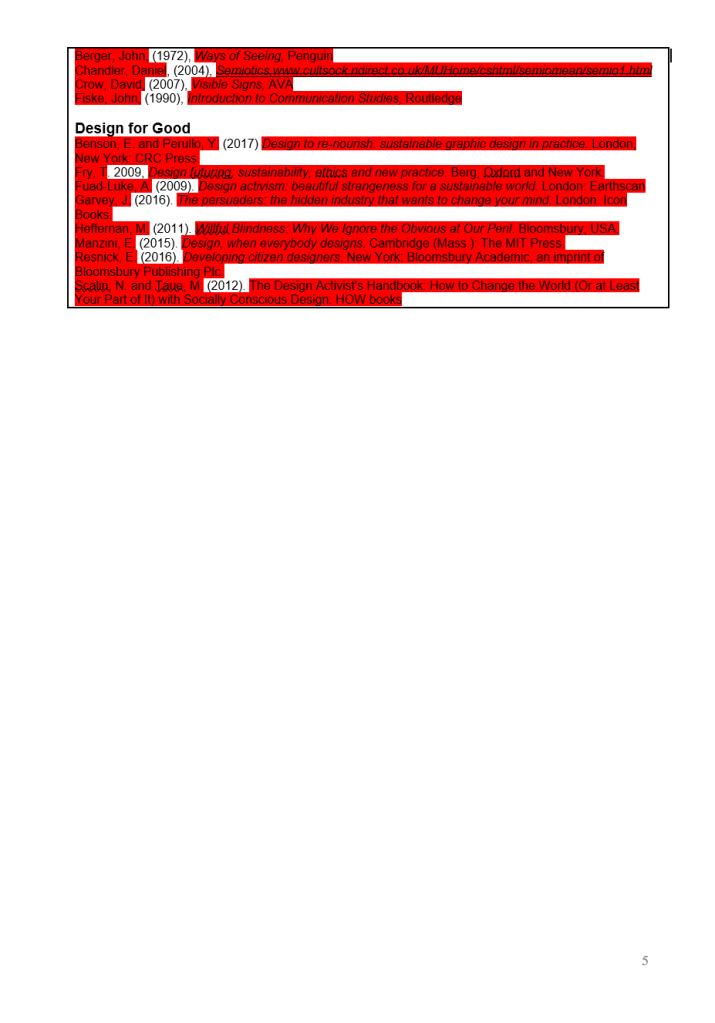As mentioned in my first brief analysis and evaluation I will now be analysing all of my briefs in great detail to ensure I have a great understanding of what is expected from me throughout this project. Like all briefs, I always read through them and highlight anything that I think will be important later in in the project, with the intention of referring back to the brief to help guide my thought process and idea generation – aiming to successfully meet the aims and objectives. My analysis can be seen below:
Lets cover the basics first. The due date for this project is a little different, the date mentioned on the brief is for the second part of this project – Creative Conscience and is set for Friday 12th February, the first part of this project is recorded a little differently. Project X is the first part of this project and as we are working through this part in a team, we have a schedule to follow put together by the tutors which works in a day-by-day system, which should hopefully announce the deadline date within their planned schedules. Like every project, all work must be my own and made for this project, if needed we should reference anything used to avoid accusations of plagerism. Any work delivered after the deadline (unless otherwise stated by the tutors) will be failed immediately. Finally, everything should be included within my blog and clearly labelled for the ease of finding my work. With that over, lets move on to the complicated stuff:
The Principal Objectives:
- To explore visual communication in Design for Good (social design)
- To develop skills of designing to communicate complex or contentious information
- To engage others in interactive design
- To create an entry for a design competition
Everything written in the principal objectives is quite clear and understandable. The first objective above states that we must explore and focus on visual communication within the topic of Design for Good – a concept for social design which allows the designer to create something that supports, engages and helps the audience. As for the second objective, it states that we must develop our design skills to ensure that the complex level of communication and information is seen, understood and valid. The third objective, focuses on the engagement level of our designs, which should hopefully be an aspect of interactive design that reaches the audience. Lastly, and this objective connects more to the second part of the project, we must create an entry for the Creative Conscience competition – this is something that we have free reign on, but as this is connected to Project X and Creative Conscience is a competition focused on Design for Good, we must make sure that our design entry supports and influences the audience in a positive manner.
The Assessment Criteria
The intended subject specific learning outcomes.
- An increased awareness of the constraints and opportunities of a design brief.
- Developed a deeper understanding of and ability to evaluate solutions to a design brief that encompass set criteria.
- Increased awareness of professional practice in the current design industry
- Demonstrated ability to work to professional practice standards
The intended generic learning outcomes.
- Developed their ability to solve design problems within the structure of a design brief.
- Developed awareness of the concepts and practice of graphic design needed to underpin the creative process.
- Applied the practice of thorough and relevant research as an aid to the development of individual creativity.
- Developed creative ability to solve design problems.
- Developed awareness of and ability to build own professional practice
Everything written above within the section of ‘Assessment Criteria’ is what Tim and Sancha will be looking for in our work to assess us on. It is clear to me that everything listed above should be evident throughout my work. While everything above is daunting, it is also important that it is covered to ensure a high grade. Everything stated above is quite clear and links to the prevelent ideals of professional practice, as well as problem solving and creative abilty. In addition to this, the objectives above want us to develop on our previous learning, such as communication and design process. To ensure that I follow these objectives, I will be making references back to the brief when appropriate and needed.
The Brief
Preamble
As usual at the start of the New Year, all three year-groups of Graphic Design, will form teams to work together on a complex issue. This helps you to understand and take part in design that potentially can help society.
The format of Project X will be as usual: approx. 6 working days (and the days in between) working in teams to ideate and prepare provotypes on the topic of inclusivity. Then the rest of the term working individually on a topic of your own choice for a Creative Conscience brief. See the choice of briefs here. Please note you must follow the brief and instruction given in the competition as well as your own year group module learning outcomes https://1wf4qdlsxta3jgqm63wz83lx-wpengine.netdna-ssl.com/wp-content/uploads/2020/09/Creative-Conscience-Briefs-2020-21.pdf .
Please also see the advice notes at the end of the brief.
Assessment Task
The project falls into two sections or tasks. BOTH parts are graded and so will require full blog write-ups and evidence of final pieces.
Brief Part 1: Inclusivity charrette
You will be allocated a team and a team topic ( the latter drawn at random). The topics are sub-divisions of the wider subject of inclusivity – race, gender, ability and poverty. In your teams you will research these topics in detail, decide on an angle or approach to follow, ideate, plan, evaluate and design a design artefact that can be digitally disseminated (on social media and otherwise). The design will be a ‘conversation starter’ or ‘provotype’ (short for provocative prototype) that will engage the audience and give them an experience that relates to the idea of inclusivity or lack of inclusivity. As well as raising awareness the design should stimulate opinions and ideas amongst the public of how the issue could be addressed.
If you feel that the issues of inclusivity or exclusivity are made worse by lockdown etc you are free to draw in that angle too. The final team-made designs will be shared by you on social media platforms (you may start new accounts if you do not wish to include these on your current ones). The feedback you get will be shared amongst the groups on the appointed day and you will use this to target-set for your Creative Conscience designs as appropriate.
Part 1 Deliverables:
You must include on your blog commentaries and evidence of all work to meet the learning outcomes of your year-group’s module.
Your blog must also include the final groupwork piece or a link to it. You must present any ‘moving parts’ in a way that can be seen by staff assessors and the examiner.
You should discuss the group dynamics but only in a professional manner. If you have something to say that cannot be blogged email both tutors.
Any Inclusivity piece not delivered by uploading/posting by the due date in January at the end of the charrette will count as a late submission and will reduce the entire groups’ grade (esp those undertaking professional practice modules).
Brief Part 2: Creative Conscience
Select one of the briefs from the 2021 Creative Conscience competition (https://www.creative-conscience.org.uk/awards/ ) and create a design. You should follow the submission guidance in the CC briefs and submit printed copies to us. You do not have to submit to the competition, but you are encouraged to, as we have had shortlisted students in previous years. Check the deadline – it may be better to submit to the competition after the final submission to ensure the best quality.
Part 2 Deliverables:
Final printed pieces (or film etc in viewable format, as appropriate). Submit in hard copy portfolio, as well as including final digital images on the last blog post AND on your blog portfolio page. In addition, make use of mock-ups where possible.
All parts of the blog to be finished, including final evaluations, on the due date by 15.30.
This brief outlines the two parts that we must complete – Project X and Creative Conscience. For Project X, we must complete the Inclusivity Charratte within our groups we will research our given topic in detail, decide on an angle or approach to follow, ideate, plan, evaluate and design a design artefact that can be represented on social media. The design should be something that engages the audience and give them an experience that relates to the idea of inclusivity or lack of inclusivity. But overall, the design should be something that raises awareness for our given topic. Moving on to the second part of this project – Creative Conscience, we are expected to create a design that follows the guidelines of the one of the 5 briefs put forward by the competition itself. This design idea and process, will come at a later date, most likely when Project X is finished!
I have to be honest, I hate Project X… We did it last year when I was a HND1 student, and I struggled with understanding the purpose, reasoning and intentions behind it. And even know that I am in HND2, I feel exactly the same…actually, maybe a little worse because I know how we are meant to handle this project and I no longer have any optimism on enjoying Project X anymore. However, on a more positive note, the second part of this brief, Creative Conscience is far more enjoyable and I can’t wait to start this section of the brief. It is the only element that I actually enjoy of this entire project… Sorry to be so negative, but Project X is just unenjoyable, and it completely stresses me out to the point where I get pain headaches. I will never enjoy it…




